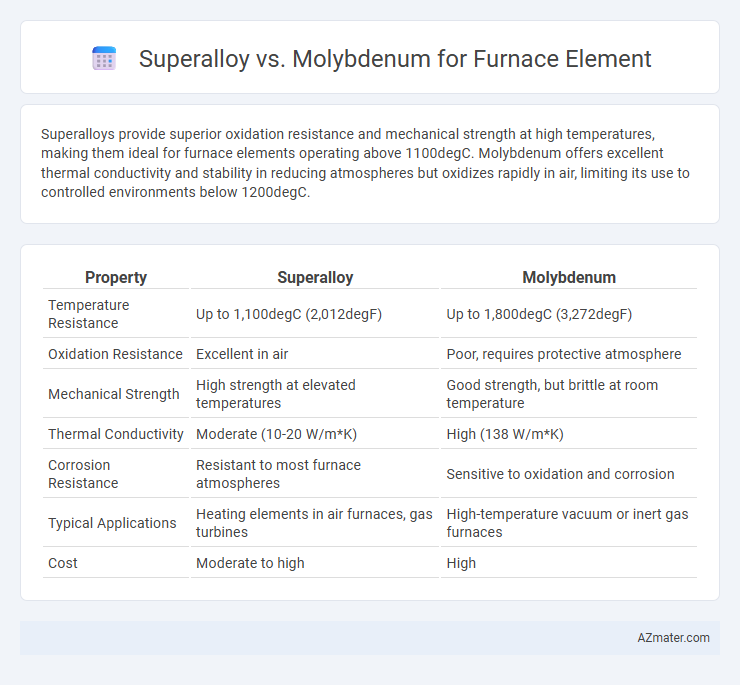Superalloys provide superior oxidation resistance and mechanical strength at high temperatures, making them ideal for furnace elements operating above 1100degC. Molybdenum offers excellent thermal conductivity and stability in reducing atmospheres but oxidizes rapidly in air, limiting its use to controlled environments below 1200degC.
Table of Comparison
| Property | Superalloy | Molybdenum |
|---|---|---|
| Temperature Resistance | Up to 1,100degC (2,012degF) | Up to 1,800degC (3,272degF) |
| Oxidation Resistance | Excellent in air | Poor, requires protective atmosphere |
| Mechanical Strength | High strength at elevated temperatures | Good strength, but brittle at room temperature |
| Thermal Conductivity | Moderate (10-20 W/m*K) | High (138 W/m*K) |
| Corrosion Resistance | Resistant to most furnace atmospheres | Sensitive to oxidation and corrosion |
| Typical Applications | Heating elements in air furnaces, gas turbines | High-temperature vacuum or inert gas furnaces |
| Cost | Moderate to high | High |
Introduction to Furnace Element Materials
Superalloy and molybdenum are two critical materials used in furnace elements, each offering distinct thermal and mechanical properties. Superalloys provide excellent oxidation resistance and strength at high temperatures, ideal for prolonged furnace operation in oxidizing atmospheres. Molybdenum excels in high thermal conductivity and stability under reducing conditions, making it suitable for specialized high-temperature furnace elements where oxidation is minimal.
Overview of Superalloys
Superalloys, primarily composed of nickel, cobalt, or iron, exhibit exceptional high-temperature strength, corrosion resistance, and oxidation resistance, making them ideal for furnace elements exposed to extreme conditions. Their complex microstructure, often stabilized by elements such as chromium, aluminum, and titanium, enhances mechanical performance at temperatures exceeding 1000degC. Compared to molybdenum, superalloys offer superior thermal stability and longevity in oxidative and corrosive furnace environments, despite molybdenum's advantages in thermal conductivity and cost.
Properties of Molybdenum
Molybdenum exhibits exceptional high-temperature strength and excellent thermal conductivity, making it ideal for furnace elements subjected to extreme heat and thermal cycling. Its low thermal expansion coefficient reduces the risk of deformation, while its resistance to creep and oxidation extends element lifespan in harsh furnace environments. These properties enable molybdenum to maintain structural integrity and performance in high-temperature industrial applications compared to many superalloys.
Temperature Resistance: Superalloy vs Molybdenum
Superalloys exhibit superior temperature resistance compared to molybdenum, maintaining structural integrity at temperatures exceeding 1,200degC due to their complex compositions including nickel, cobalt, and chromium. Molybdenum, while offering high melting points around 2,623degC, suffers from oxidation issues at elevated temperatures above 1,100degC, limiting its effective use in oxidizing environments. This makes superalloys more suitable for furnace elements operating under extreme thermal and oxidative stress.
Oxidation and Corrosion Resistance Comparison
Superalloys exhibit superior oxidation resistance due to their high chromium and aluminum content, forming a stable oxide layer that protects furnace elements under high-temperature conditions. Molybdenum offers excellent strength but is more susceptible to oxidation and corrosion at elevated temperatures, especially in oxidizing atmospheres, limiting its longevity in furnace applications. The corrosion resistance of superalloys makes them ideal for harsh environments, while molybdenum requires protective atmospheres or coatings to maintain performance.
Mechanical Strength and Durability
Superalloys exhibit superior mechanical strength and high-temperature resistance compared to molybdenum, making them ideal for furnace elements subjected to extreme thermal cycling and stress. Molybdenum offers excellent thermal conductivity and oxidation resistance but tends to suffer from creep deformation and brittleness at elevated temperatures above 1200degC. The enhanced durability of superalloys in oxidative and corrosive furnace environments significantly extends service life, reducing maintenance and replacement frequency.
Cost-Effectiveness Analysis
Superalloys offer high-temperature strength and oxidation resistance but come with significantly higher material and manufacturing costs compared to molybdenum, which provides excellent thermal conductivity and lower cost yet lower oxidation resistance at elevated temperatures. Molybdenum furnace elements are often more cost-effective for applications below 1100degC where oxidation is manageable with protective atmospheres, whereas superalloys become economically justified in extreme temperature environments exceeding 1200degC due to longer service life and less frequent replacement needs. A thorough cost-effectiveness analysis must factor in raw material price, element longevity, operational temperature, and maintenance intervals to determine the optimal choice for specific furnace applications.
Applications in Industrial Furnaces
Superalloys are ideal for industrial furnace elements due to their exceptional resistance to high-temperature oxidation and thermal fatigue, making them suitable for continuous operation in harsh environments like gas and electric furnaces. Molybdenum offers superior high-temperature strength and excellent thermal conductivity but is more prone to oxidation, limiting its use to controlled atmospheres such as vacuum or inert gas furnaces. Industrial applications favor superalloy elements in oxidizing environments for prolonged durability, while molybdenum is preferred in reducing or inert atmospheres for maintaining structural integrity at extreme temperatures.
Maintenance and Lifespan Considerations
Superalloy furnace elements offer enhanced oxidation and creep resistance, resulting in longer maintenance intervals and extended lifespan compared to molybdenum elements, which are prone to accelerated oxidation at high temperatures. Molybdenum elements require more frequent inspections and replacements due to their susceptibility to embrittlement and surface degradation under oxidative furnace environments. Prioritizing superalloys in furnace applications reduces downtime and overall maintenance costs by improving element durability and thermal stability over prolonged operating cycles.
Conclusion: Choosing the Right Furnace Element Material
Selecting the right furnace element material depends on factors like operating temperature, corrosion resistance, and mechanical strength. Superalloys excel in high-temperature environments up to 1200degC with excellent oxidation resistance and durability, ideal for long service life in harsh conditions. Molybdenum offers superior thermal conductivity and stability in reducing atmospheres but is limited by lower oxidation resistance, making superalloys the preferred choice for most high-temperature furnace applications.

Infographic: Superalloy vs Molybdenum for Furnace Element
 azmater.com
azmater.com